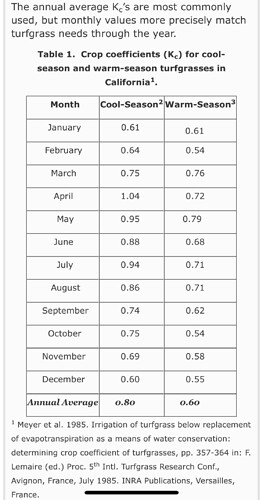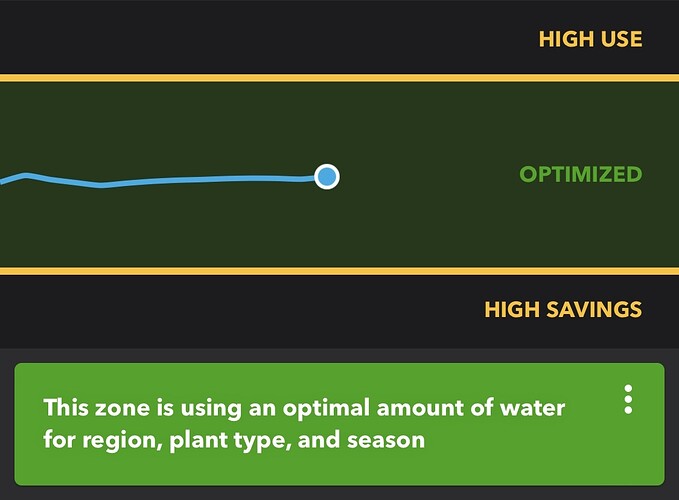Does a crop coefficient twice a large water twice as frequent? For example will a plant at 60% Crop Coefficient need to be watered twice a often as a plant with a Crop Coefficient of 30%? The weather and soil conditions are assumed to be the same.
Not exactly but that is one approximate way to look at it. The crop coefficient scales the day’s ET0 or reference evapotranspiration, and that changes day to day.
Should I increase the crop coefficient in excessive heat?
My shrubs and trees are on the one zone wonder. I use the shrub watering depth of 16 inches and the crop coefficient of 0.75, which is the standard tree recommendation
You shouldn’t have to. The calculated ET (Evapotranspiration) value takes the heat, humidity, sun, wind, etc. into account, so that’s what does it. Now, if you find your crops drying out too much, you might increase it just because it probably needs it to fine-tune, as hot weather will bring a lack of water to light sooner than cool.
It appears crop coefficients might change throughout the year for certain plants. If so, can Rachio make it an option to have automatically adjusting crop coefficients?
@ECOBEARD I appreciate your curiosity about this topic. Good news! We are currently developing a “dynamic crop coefficient” feature we will release this spring (2022) that will automatically provide specific crop coefficients for each month of the year for all crops. We’ve combed the available research to come up with crop coefficient curves that are specific to months, plants, and regions. For example, the table you posted with the Meyer 1985 data provides coefficient values for cool and warm season grasses in a mediterranean climate, so most Rachio controllers in mediterranean parts of CA, OR, etc will get those coefficients. However, Rachio controllers in Denver, Seattle, New York, Miami etc will each get their own set of coefficient curves according to their local climate.
This should provide a more accurate watering experience for all our customers, and will hopefully solve some over-watering and under-watering issues that can occur in some parts of the country due to annual average crop coefficients not keeping up with seasonal variability.
We’ll provide in-depth background material when we release the feature (existing customers will have to opt into it, and we’ll explain how). If you want to learn more about the topic, the UC ANR sources posted in this thread are good sources of information.
For anyone curious about crop coefficients for specific agricultural crops, there is a wealth of published research, but it can be laborious to sift through. This page from the UN Food and Agriculture Organization (FAO) has a very comprehensive set of tables for crops organized around growing seasons: Chapter 6 - ETc - Single crop coefficient (Kc). We took this information into account while creating more simplified crop coefficient curves for vegetable and flower garden zones.
I’m interested in how that will work so it won’t change the crop coefficient too much or too little. How would one change the crop coefficient up or down a little from the deafault if it’s dynamic? Would this new dynamic crop coefficient feature save more water than the static crop coefficient?
Any other interesting upcoming features coming to Rachio?
@ECOBEARD The balance between too much and too little change… therein lies the rub, as they say. We’ve made our models of dynamic crop coefficients using the best available science and erring towards the Rachio default, i.e. a conservative interpretation of the amount of variability within a year.
This feature will be available to toggle on/off in the Advanced Settings for each zone. A customer may at any time turn the “dynamic” feature off, in which case the crop coefficient will be re-set to the default, which can still be manually adjusted to whatever they choose.
While it is hard to test the real affects of these coefficient changes, simulations have convinced us that the dynamic coefficient values will yield water savings in some regions and seasons. A prime example is fall watering in a steppe/ semi-arid climate like I live in here in Denver. Daily evapotranspiration can remain relatively high due to warm, sunny, and windy fall days, but cool season grasses just don’t need nearly as much water as they did in August, due to their own biochemistry and the receding sun angle. So the Kc value throttling down over the fall will save water in this case, while also more likely providing enough water (avoiding under-watering) in the peak ET months of July, August, and September.
We will announce more information about this feature soon, stay tuned!
As someone who lives in northern California, this feature is going to be awesome! My lawn gets absolutely nuked during the summer months and I have a phone reminder to adjust my grass crop coefficients on the first of every month according to the chart posted above. When using the default 80% throughout the year, I also see the opposite issue of water being applied too frequently in the cooler months, which has resulted in a nice infestation of rust and Pythium blight fungal infections. Not cheap to treat!
If I opt into this dynamic crop coefficient, will there be any option for an offset to the dynamic number?
For instance, I have one of my cool-weather grass zones saturated in tree roots in the soil. These suck up so much water, so the ‘fix’ I use is I increase the root depth from 6" to 8" and offset the crop coefficient from that chart above to +0.2. That way it applies more water at once, but also keeps the watering frequency the same as my other zones. I would like to use this dynamic number, but also have it apply a constant offset to keep this zone happy.
Maybe you already provided it and I missed it . . . where can we fix the coefficient curve for my area?
HI @spaceman_spiff , your experience is exactly the kind of problem we had in mind in designing this feature. I think you’ll be pleased with the results.
We are getting ready to release this feature soon this Spring and have not included an offset in the first release feature set, but it’s a good idea and we’ll definitely consider it for updates. We’re always iterating and trying to improve our features.
@ECOBEARD This indeed is a beta test of a feature we are trying out. We are comparing your zone’s water use to a basic water-to-et simulation; the idea is to provide home irrigators with some useful feedback so they can have an idea of the effect of adjustments they make.
I’m very curious if you have any impressions with this feature and if you’ve interacted with it at all (i.e. have you used the “water a little more”/ “water a little less” buttons?
@Thomas_Lerman as we’re getting close to releasing our dynamic crop coefficient feature, I’m going to publish some documents (likely a community forum post too) that will have links to all the Kc curves for all the crops. Stay tuned, and I’ll be sure to mention you when the docs are out.
Appreciate your curiosity!
Sounds great, thank you. I actually meant to say, “where can we FIND the coefficient curve for my area?” That might be in the documents and post. Maybe we would not need it if the dynamic is automatic.
Any updates on the dynamic crop coefficient function?
We are doing final quality assessment and hope to release it within the next two weeks!
I am looking forward to it. I wonder how this will work if you know your area doesn’t fall into the default crop coefficient for a certain plant type. For example, I primarily have Turf Type Tall Fescue and Hybrid Bluegrass that appear to need less water than the average cool-season crop coefficient curve, especially because I only use slow-release fertilizers. Crop coefficients appear to be a spectrum and not a hard number.
Definitely looking forward to this. The missing link. Have been using your controllers since they first came out. Now on Gen 3.
My iOS app now has this dynamic crop coefficient option in the advanced menu for my zones. Sweet!
I did notice that my cool-weather grass here in northern CA is assigned a 97% coefficient, but the table I’ve been using shows 104% for April here in CA:
https://ucanr.edu/sites/UrbanHort/Water_Use_of_Turfgrass_and_Landscape_Plant_Materials/Turfgrass_Crop_Coefficients_Kc/
I realize that probably isn’t a huge difference, but kind of curious how Rachio is getting it’s data? Is it location-adjusted at all?


